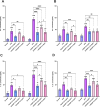The Effect of Osthole on Transient Receptor Potential Channels: A Possible Alternative Therapy for Atopic Dermatitis
- PMID: 38351985
- PMCID: PMC10863468
- DOI: 10.2147/JIR.S425978
The Effect of Osthole on Transient Receptor Potential Channels: A Possible Alternative Therapy for Atopic Dermatitis
Abstract
Introduction: Chronic recurrent skin inflammation and severe itching in patients with atopic dermatitis (AD) significantly impair their quality of life. The H4 histamine receptor plays a key role in histamine-induced itching. During the skin inflammation associated with AD, pro-inflammatory mediators (interleukins, cytokines) are released from neurons. Ultimately, a cascade of reactions leads to the activation and sensitization of transient receptor potential channels (TRP), which exacerbate the inflammation and itching associated with AD. Osthole (OST) is a natural coumarin with a proven versatile pharmacological effect: anti-cancer, anti-inflammatory and immunomodulatory. However, the molecular mechanism of OST in relieving inflammation in histamine-mediated itching is not yet clear.
Purpose: In the studies presented, the possible effect of the OST action on the inhibition of the gene expression of the histamine H4 receptor and the key genes of the TRP channels as well as on the concentration of proinflammatory interleukins was analyzed.
Methods: Inflammation was induced in a 3D skin model and a keratinocyte cell line Normal Human Epidermal Keratinocytes (NHEK) identical to that of AD, and then OST was administered at various doses. The concentrations of IL-4/-13 were determined by ELISA. RNA was isolated from the 3D skin cells and the NHEK cell line, and the qPCR method was used to determine the expression of: IL-4α, H4R, TRPV1, TRPV4, TRPM8 analyzed.
Results: The study showed that OST significantly reduced the secretion of IL-4/-13 in a keratinocyte cell line and in a 3D skin model. In addition, OST was found to significantly decrease the gene expression of IL-4α, H4R, TRPV1, TRPV4 and increase TRPM8 in both the NHEK cell line and the organotypic 3D skin model.
Conclusion: The data obtained provide the first in vitro evidence of itch relief following the application of OST to atopic skin. Research on the use of OST as an active component of emollients in the treatment of AD should be continued in the future.
Keywords: 3D skin; CP; TRPV channels; clobetasol propionate; keratinocytes; pro-inflammatory cytokines.
© 2024 Kordulewska and Król-Grzymała.
Conflict of interest statement
The authors report no conflicts of interest in this work.
Figures





Similar articles
-
Osthole Inhibits Expression of Genes Associated with Toll-like Receptor 2 Signaling Pathway in an Organotypic 3D Skin Model of Human Epidermis with Atopic Dermatitis.Cells. 2021 Dec 28;11(1):88. doi: 10.3390/cells11010088. Cells. 2021. PMID: 35011650 Free PMC article.
-
Osthole Regulates Secretion of Pro-Inflammatory Cytokines and Expression of TLR2 and NF-κB in Normal Human Keratinocytes and Fibroblasts.J Inflamm Res. 2022 Mar 1;15:1501-1519. doi: 10.2147/JIR.S349216. eCollection 2022. J Inflamm Res. 2022. PMID: 35261546 Free PMC article.
-
Th2 Modulation of Transient Receptor Potential Channels: An Unmet Therapeutic Intervention for Atopic Dermatitis.Front Immunol. 2021 Jun 30;12:696784. doi: 10.3389/fimmu.2021.696784. eCollection 2021. Front Immunol. 2021. PMID: 34276687 Free PMC article. Review.
-
Jiawei guomin decoction regulates the degranulation of mast cells in atopic dermatitis mice via the HIS/PAR-2 pathway.J Ethnopharmacol. 2024 Mar 1;321:117485. doi: 10.1016/j.jep.2023.117485. Epub 2023 Nov 24. J Ethnopharmacol. 2024. PMID: 38008276
-
The role of histamine H1 and H4 receptors in atopic dermatitis: from basic research to clinical study.Allergol Int. 2014 Dec;63(4):533-42. doi: 10.2332/allergolint.13-RA-0675. Allergol Int. 2014. PMID: 25249063 Review.
Cited by
-
Schizonepeta tenuifolia Briq-Saposhnikovia divaricata decoction alleviates atopic dermatitis via downregulating macrophage TRPV1.Front Pharmacol. 2024 Aug 27;15:1413513. doi: 10.3389/fphar.2024.1413513. eCollection 2024. Front Pharmacol. 2024. PMID: 39257398 Free PMC article.
-
Osthole: A Coumarin with Dual Roles in Biology and Chemistry.Biology (Basel). 2025 May 22;14(6):588. doi: 10.3390/biology14060588. Biology (Basel). 2025. PMID: 40563840 Free PMC article. Review.
References
LinkOut - more resources
Full Text Sources
Research Materials
Miscellaneous

